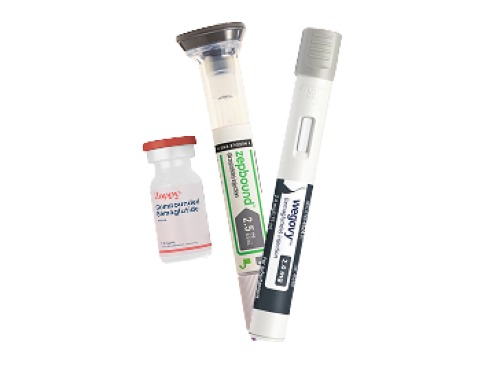Tirzepatide, a relatively new and highly effective drug, has revolutionized the treatment of type 2 diabetes and obesity. Its dual action on GLP-1 (glucagon-like peptide-1) and GIP (glucose-dependent insulinotropic polypeptide) receptors gives it a unique mechanism that has led to improved blood sugar control and significant weight loss for many patients. However, with any new medication comes the question of side effects. One of the key concerns for patients and healthcare providers alike is, can tirzepatide cause headaches?
In this comprehensive blog, we’ll explore this potential side effect in depth, along with other considerations around tirzepatide use. We’ll also look into the mechanisms behind these side effects and offer advice on how to manage headaches if they occur while taking this medication.
Understanding Tirzepatide: How Does It Work?
Before diving into whether tirzepatide injections side effects include headaches, it’s essential to understand what tirzepatide is and how it works. Marketed under the brand name Mounjaro, tirzepatide is a once-weekly injectable medication approved by the FDA for the treatment of type 2 diabetes. It works by activating both GLP-1 and GIP receptors, which are responsible for enhancing insulin secretion, lowering blood sugar, and regulating appetite.
By targeting both receptors, tirzepatide not only helps improve blood sugar control but also promotes significant weight loss, making it a breakthrough drug for both diabetes and obesity management.
To learn more about tirzepatide, check out our blog about glp-1 medications.
Common Side Effects of Tirzepatide
Like any medication, tirzepatide comes with a range of potential side effects, some of which are more common than others. According to clinical trial data from the SURPASS studies, the most frequently reported side effects include:
- Nausea
- Vomiting
- Diarrhea
- Decreased appetite
- Constipation
While gastrointestinal side effects are the most common, there are reports of headaches in some patients. However, headaches are less frequently discussed compared to nausea or vomiting.
Can Tirzepatide Cause Headaches?
Now, to the primary question: can tirzepatide cause headaches? The answer is yes, though headaches are not among the most common side effects of tirzepatide. They occur in a smaller percentage of users, but they do happen.
Here’s why tirzepatide may cause headaches:
- Gastrointestinal Side Effects and Dehydration: One of the key reasons tirzepatide may cause headaches is due to the gastrointestinal side effects such as nausea, vomiting, and diarrhea. These symptoms can lead to dehydration, which is a known trigger for headaches. If a patient experiences frequent vomiting or diarrhea, they may not be retaining enough fluids, leading to dehydration-induced headaches.
- Blood Sugar Fluctuations: Another potential cause of headaches could be blood sugar fluctuations. Tirzepatide works by lowering blood sugar, but if it drops too low (hypoglycemia), headaches can occur. Patients on tirzepatide need to monitor their blood sugar closely to ensure it stays within the recommended range, as hypoglycemia can lead to headaches, dizziness, and fatigue.
- Body’s Adjustment to the Drug: Starting a new medication can cause the body to undergo an adjustment period. Some patients report experiencing headaches as their body gets used to tirzepatide. This adjustment phase can last for a few weeks, and headaches may subside as the body adapts to the medication.
- Direct Impact on the Central Nervous System (CNS): Though tirzepatide primarily affects the gastrointestinal system and blood sugar levels, some GLP-1 receptor agonists are known to influence the central nervous system. Since tirzepatide affects GLP-1 receptors in the brain, it’s possible that this could lead to headaches, though this is less common.
Clinical Data on Tirzepatide and Headaches
In the SURPASS clinical trials, headaches were reported as a side effect, though they were not among the most common complaints. Most participants experienced gastrointestinal side effects like nausea and vomiting. However, less than 5% of participants reported headaches, indicating that while it is possible, it is not a widespread issue.
In most cases, the headaches reported were mild to moderate in severity and resolved without the need for medical intervention. As with many new medications, it’s essential to monitor any side effects closely and report them to a healthcare provider.
For a more detailed breakdown of the clinical trials, check out the official trial data available on ClinicalTrials.gov.
How to Manage Headaches Caused by Tirzepatide
If you’re experiencing headaches while taking tirzepatide, there are several strategies you can try to alleviate the discomfort. Here are some tips to help manage headaches:
- Stay Hydrated: One of the primary causes of headaches is dehydration, which can occur if you are experiencing vomiting or diarrhea. Make sure to drink plenty of water throughout the day to stay hydrated. If necessary, consider electrolyte solutions to help replenish any fluids lost due to gastrointestinal side effects.
- Monitor Your Blood Sugar: Blood sugar fluctuations can cause headaches, particularly if you experience low blood sugar (hypoglycemia). It’s important to monitor your blood sugar levels regularly, especially after meals. If you notice any dips in blood sugar levels, consume a small snack that’s rich in carbohydrates to help stabilize it.
- Small, Frequent Meals: Instead of eating large meals, consider having smaller, more frequent meals throughout the day. This can help prevent blood sugar spikes and drops, which may reduce the likelihood of headaches.
- Rest and Relaxation: Stress and fatigue can contribute to headaches. Make sure to get enough rest and consider relaxation techniques such as deep breathing exercises, meditation, or yoga to help alleviate tension.
- Consult Your Healthcare Provider: If headaches persist or become more severe, it’s essential to consult your healthcare provider. They may recommend over-the-counter pain relievers or adjust your dosage to help minimize side effects.
Tirzepatide vs. Other GLP-1 Agonists: Are Headaches More Common?
Headaches are not unique to tirzepatide and can occur with other GLP-1 receptor agonists as well. For example, semaglutide (sold under the brand names Ozempic and Wegovy) also lists headaches as a potential side effect, though they are similarly uncommon.
One of the main differences between tirzepatide and semaglutide is their mechanism of action. Tirzepatide targets both GLP-1 and GIP receptors, while semaglutide only targets GLP-1 receptors. This dual action in tirzepatide may contribute to a different side effect profile, though the occurrence of headaches is comparable between the two medications.
If you’re experiencing persistent headaches on tirzepatide, you may want to explore alternative treatments like semaglutide. Read our in-depth comparison of tirzepatide and semaglutide to understand how these medications differ and whether one might be better suited to your needs.
When to Seek Medical Attention
While most headaches caused by tirzepatide are mild and can be managed with hydration and rest, there are certain cases where medical attention may be necessary. Contact your healthcare provider if:
- Your headaches are severe or persistent.
- You experience additional symptoms such as dizziness, blurred vision, or nausea that doesn’t subside.
- You notice a pattern of headaches occurring after meals or with low blood sugar.
- You develop other concerning side effects like chest pain or difficulty breathing.
Your healthcare provider can assess your symptoms and may adjust your dosage or recommend a different treatment plan.
Long-Term Safety of Tirzepatide
Tirzepatide has shown promising results in managing type 2 diabetes and promoting weight loss, but as with any new medication, long-term safety is a concern for both patients and healthcare providers. So far, the safety profile of tirzepatide appears favorable, with most side effects being mild to moderate in severity.
However, ongoing research and post-market surveillance will provide more insights into the long-term safety of tirzepatide. For more information on the long-term effects of GLP-1 receptor agonists, check out our article about sustainable long-term weight loss management.
Conclusion: Can Tirzepatide Cause Headaches?
In summary, can tirzepatide cause headaches? Yes, but they are relatively uncommon compared to other side effects such as nausea or vomiting. If headaches do occur, they are usually mild and can be managed with proper hydration, blood sugar monitoring, and rest. However, if you experience severe or persistent headaches, it’s crucial to consult your healthcare provider to ensure there are no underlying health concerns.
As with any medication, it’s essential to weigh the benefits against the potential side effects. Tirzepatide has shown significant promise in managing diabetes and promoting weight loss, but it’s vital to work closely with your healthcare team to monitor any side effects and adjust your treatment plan as needed.
For more insights on managing tirzepatide weight loss side effects and optimizing your treatment, visit Zappy Health’s where we provide expert advice on living with diabetes and achieving sustainable weight loss.






